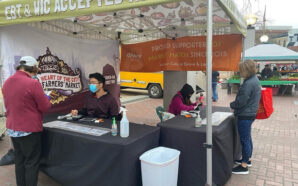Jenny Manrique
Ethnic Media Services
Disparities in health care and education. Lack of affordable housing. Racism and police abuse. Loss of jobs. These are just a few of the crises already faced by low-income communities of color, that have been exacerbated by the COVID-19 pandemic.
Closing those inequity gaps will require not only federal and state investment in these communities, but sincere attention to their mental health and a commitment from the wealthiest classes, who were marginally affected by the pandemic while preserving their income and privileges.
Experts who work directly with ethnic communities in California warn about this complicated healing process during a press conference organized by Ethnic Media Services.
“We know that COVID is the disease that has revealed our illness as a society: the valleys of inequality that pre-existed COVID have been flooded with the tsunami of the disease,” said Manuel Pastor, Distinguished Professor of Sociology and American Studies & Ethnicity and Turpanjian Chair in Civil Society and Social Change at the University of Southern California.
At the beginning and different stages of the pandemic, Pastor cautioned how COVID would especially impact immigrants who are the labor force that does the essential work treated as “disposable”.
“We’ve got (mixed-status) families that until the passage of the American Relief Act were essentially locked out of federal relief funds… Now they are kind of reluctant to tap in, because they’re worried that may count against them, if there’s eventually a route to legalization in the future”.
In California, more than two-thirds of undocumented immigrants have been in the country for longer than a decade and are waiting for Congress to work out their path to citizenship. It is a population deeply embedded in business and communities, who have experienced the disease like no other without being able to access local health programs, due to lack of insurance, mistrust and fear.
“Every state relief program should try to think about what it can do to be fully accessible to undocumented Californians,” said Pastor, who also sits on the Governor’s Council of Economic Advisers, where he pushes these issues.
Since last summer, the California Healthy Places Index already indicated that the virus was going to devastate blacks, Latinos and Asians but the state did not bring COVID tests to those communities. This health equity metric requires to assess test positivity rates in the poorest communities, to analyze their vulnerability to county opening plans.
But it was till recently with vaccination plans that the state of California made a pivot and decided to allocate 40% of vaccines into the 25% of the communities that are scoring worse on this index. Community mobile clinics receive doses, mobilize trusted messengers and run health promoters campaigns to encourage vaccination.
“The vaccine rollout has also been a recipe for racial inequality,” added Pastor, referring to the fact that although the doses were available to anyone of a certain age category or occupation, the older populations are overwhelmingly white while younger populations belong to communities of color..
“It could be argued that everyone in that age category had an equal shot at getting the shot, as long as they had a computer (to make the appointment), a high speed Internet, a kind of job where they could take three hours off in the middle of the day to chase down a vaccine and access to a car, rather than mass transit,” said Pastor.
In areas such as education, communities of color also experience a tremendous loss in learning and despite the progressive opening of schools, they are the most reluctant to come back. Black and brown families who suffered from the virus in their homes are not only afraid of sending their children to places where they can be infected, but the digital divide has accentuated their difficulties in keeping up with their homework during the school year.
In Los Angeles County, 13% of white children who are in K through 12 lacked a computer with high-speed Internet. But that figure for black and Latino children was around 40%, Pastor said.
All these inequalities only reveal that the pandemic has not caused a recession like the one that hit the economy evenly in 2008. According to the sociologist, what we face is a “micro recession” in which the stock markets and property are up, and people with incomes of more than $100,000 a year have not seen their wallets affected. But instead, those at the bottom of the labor market have received the full blow of the “economic damage”, reflected in the loss of income, employment and wages.
“We need to reposition resources and relief programs, especially for mixed-status families,” Pastor continued. “The level of mental health trauma is high and we need to have culturally sensitive mental health resources available… We need to destigmatize the issue and make it seen as something that is social and community level, and not just your individual failing, so that people feel confident accessing those resources.”
Healing circles
An example of this approach is the Community Coalition, founded in South Los Angeles by Congresswoman Karen Bass, which seeks the multiracial and multigenerational integration of communities to generate the solutions they need.
During the pandemic they instituted a teletherapy program to offer services by licensed therapists of color and healing circles in local parks, to address “the devastating impact (of COVID) all around on physical, financial and mental health,” said Leslie Johnson, Vice President of Organizational Development at Community Coalition.
They also designed a website in English and Spanish that allows residents to check on their emotional health.
“Those community healing efforts are really important and with funding and with having people in elected office that understand those kinds of interventions, we can really bring those to scale because our resources are limited,” said Johnson for whom “racism is the true pandemic that we are fighting against.”
“COVID-19 has exacerbated a lot of pre-existing conditions in our community that are fostered by institutional racism and white supremacy. We must call for solutions that are bold, not just at the individual level but at the systems level, and that address the root causes” of inequalities, she observed.
During the pandemic, her organization raised funds to buy personal protective equipment and make direct cash payments to families to help cover rent and utilities. They also provided laptops and hardware to students and installed hotspots for community members.
They managed to offer doses of Pfizer at a vaccination clinic in a local park, establishing a system of appointments that allowed people to attend even at night to not miss work. But even promoting vaccination through trusted messengers, often family or neighbors, they still face vaccine hesitancy among the community.
“The way the vaccines were rolled out didn’t make a lot of sense to us in terms of having overcrowded homes and multi-generational households,” Johnson said. “If we want to have the economy open, if we want to be able to go to restaurants and so forth, then we should go to these businesses and vaccinate the people who work there,” she added.
As part of the relief package, Los Angeles will receive about $1.3 billion from the federal government. The Community Coalition introduced a plan called Make Los Angeles Whole to use these resources in loans to women business owners, help people with rent and mortgage payments and utilities, and increase youth employment opportunities.





